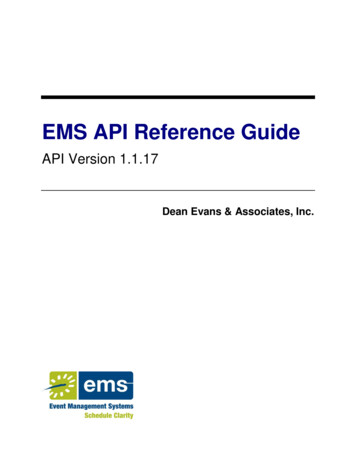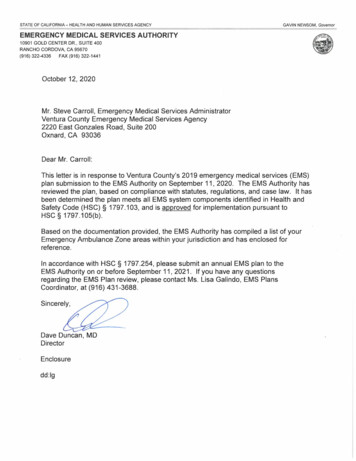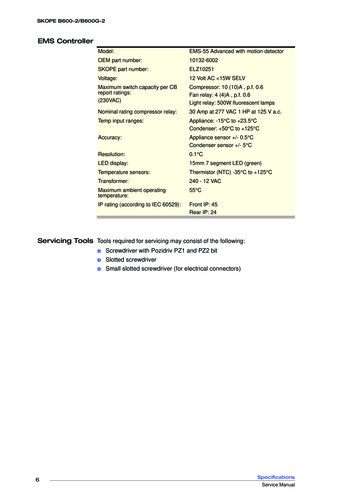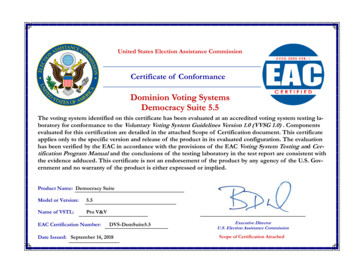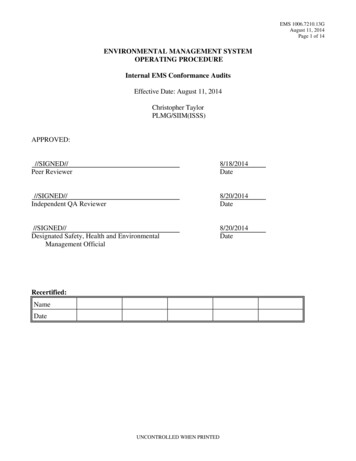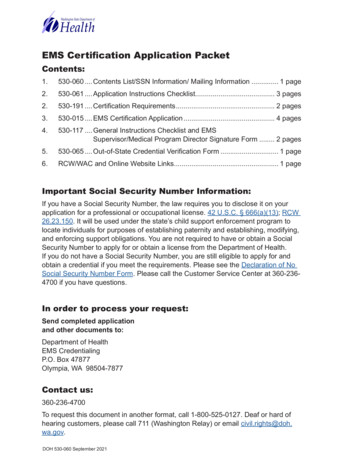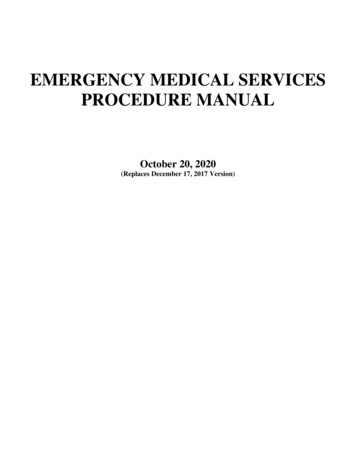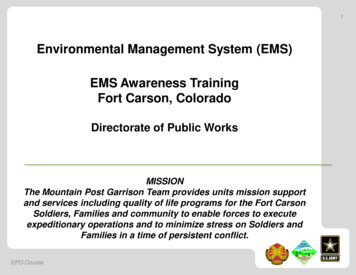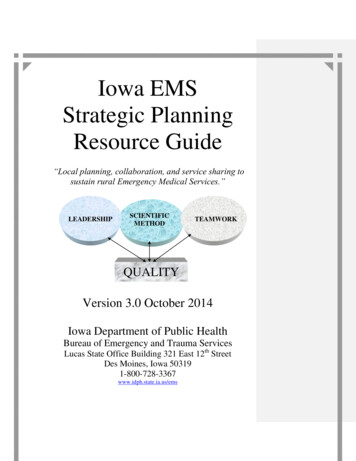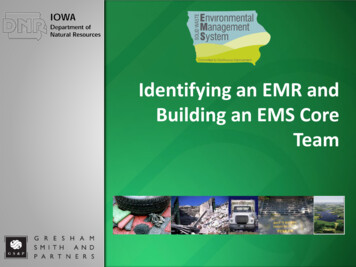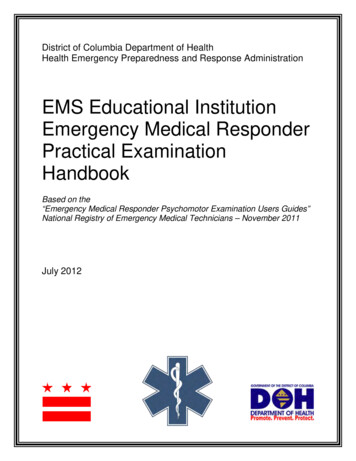
Transcription
District of Columbia Department of HealthHealth Emergency Preparedness and Response AdministrationEMS Educational InstitutionEmergency Medical ResponderPractical ExaminationHandbookBased on the“Emergency Medical Responder Psychomotor Examination Users Guides”National Registry of Emergency Medical Technicians – November 2011July 2012
EMS Educational Institution EMR Practical Examination HandbookEMS Educational Institution Educational CourseEMR Practical Examination HandbookRelease NotesJuly 2012 – Initial ReleaseDC-DOH EMS Form 2012-0021APage 2 of 90ORG: July 2012
EMS Educational Institution EMR Practical Examination HandbookRegulation and PoliciesThe following table identifies the regulations and policies that influence this 0-00122011-00152011-00162012-0021DC-DOH EMS Form 2012-0021ATitleEMS Act of 2008, Section 8Emergency Medical Technician CourseEMS Educational InstitutionCertification StandardsEMS Instructor StandardsEMS Curriculum and Course StandardsEMS National Education StandardsTransition ProceduresEMR Practical Examination StandardsPage 3 of 90Effective Date01 June 200904 Dec 199801 Dec 201001 Dec 201001 Aug 201101 Aug 201101 Oct 2012ORG: July 2012
EMS Educational Institution EMR Practical Examination HandbookPrefaceWith the adoption of the National Registry of Emergency Medical Technicians certificationrequirement in the District, we have also adopted the NREMT practical examination standard.To assist our educational institutions with the practical examination process, we have patternedthis handbook around the NREMT basic life support practical exams. The majority of thishandbook is taken from information contained in the EMR Psychomotor Examination UsersGuide that was developed by the National Registry of Emergency Medical Technicians. Thishandbook includes the updates included in the National Education Standards. It is designed to beused in conjunction with the Practical Skill Station Scenario booklet which is maintained by theEMS Division at the Health Emergency Preparedness and Response Administration (HEPRA) atthe DC Department of Health (DOH).The handbook is divided into four sections: Conducting a Practical Skill Examination Examination Forms Individual Examination Stations – Instructions and Scripts Signs for Examination StationsThe “Conducting a Practical Skill Examination” section contains information to help organizeand track the practical skill examination stations. It includes the duties of the ExaminationCoordinator, the Examination Staff, and the Exam Candidates. Information is included on issuesthat may arise with the candidates and how such concerns should be addressed. Examinationresults and how to address examination failures is also discussed. This section also includes alisting of the minimum passing scores and times limits for all of the stations, as well as thenumber and types of personnel that would be needed to staff all of the stations.The “Examination Forms” section includes the DOH required forms as well as several forms foryour convenience. The Examination Stations Staff Chart allows you to fill in the names of thevarious individuals that will be assisting with the practical exam and the role they will be taking.There is a Practical Exam Checklist to assist you in making sure everything is ready toadminister the exam. There are student practical skill cards for the students to use. This will helpthem keep track of what stations they have taken.The required forms include the Candidates Statement, the EMR Practical Examination CandidateReporting Form, the Complaint Form, the Complaint Reporting Form and the QA CommitteeReview Form.The “Practical Exam Roster” is a required form that is used to track all of the students taking theexam. It includes the minimum passing scores for each station, maximum time period, a columnto record their attendance, a column to record the student’s score for each station, and a columnto mark their overall results. This must be signed by the Examination Coordinator and theDistrict’s EMS Official. This document will be kept with the course record at the educationalinstitution.DC-DOH EMS Form 2012-0021APage 4 of 90ORG: July 2012
EMS Educational institution EMR Practical Examination HandbookThe third section of the handbook is divided into segments for orientation scripts for examinationstaff and candidates, as well as specific testing infonnation for each of the various examinationstations. In each station section you will find a page that list the time limit for the station, theequipment needed, the number and type of personnel needed and the minimum passing score.The next page contains the instructions to the Skill Examiner for the station. There is also a pagethat gives instructions to the Candidate. Several stations also contain instructions for theSimulated Patient. Lastly, a copy of the NREMT Skill Sheet for that station is included.The final section is the "Individual Examination Station Signs." We have included signs that youcan printout for all of the Practical Skill Stations as we ll as the Student Staging Area.This guide will change over time as new skill procedures are enacted and old skill proceduresdiscontinued. You should always feel free to contact the EMS Division at the Department ofHealth anytime you have questions concerning anything dealing with these skill scenarios oranything concerning EMS certifications or educational issues.We hope that you find this Examination Station Handbook useful. If you see mistakes in thishandbook please Jet us know. We are working hard to improve the services offered by the EMSDivision, and we are working to be responsive to your needs as EMS educators and providers.Let us know how we can best help you.Brian W. Amy, MD, MHA, MPH, FACPMSenior Deputy Director.Health Emergency Preparedness and Response Administration (HEPRA)DC·DOH EMS Form 2012'()()21APage 5 0/90ORG: July 2012
EMS Educational Institution EMR Practical Examination HandbookTable of ContentsRelease Notes. .2Regulations and Policies .3Preface .4Conducting a Practical Skill Examination .9Notification of the Department of Health .10Observation by the Department of Health .10Examination Stations .10Examination Coordinator 11Skill Examination Staff .12Skill Examiner Qualifications .12Patient Assessment/Management – Trauma .13Patient Assessment/Management – Medical .13BVM Ventilation of an Apneic Patient andOxygen Administration by Non-rebreather Mask .13Cardiac Arrest Management/AED .13Skill Examiner Responsibilities 14Exam Candidates 15Late Arrivals .15Interruption of the Psychomotor Examination .15False Identification 16Use of Prohibited Materials .16Candidates Suspected of Dishonest Action .17Irregular Behavior .17Dismissal from the Psychomotor Exam 18Examination Results 18Practical Exam Failures 18Failure of 3 or Less Skill Stations – Decision Flow Chart 21Failure of 4 or More Skill Stations – Decision Flow Chart .22Completion of the Psychomotor Examination .23Reporting the Examination Results .24Examination Station Reference Charts 25Examination Station Master Equipment Listing 26DC-DOH EMS Form 2012-0021APage 6 of 90ORG: July 2012
EMS Educational Institution EMR Practical Examination HandbookExamination Forms 27Examination Stations Staffing Chart .28EMR Practical Examination Checklist 29Skill Station Rotation Cards 30Candidate’s Statement 31EMR Practical Examination Candidate Reporting Form 32EMR Practical Examination Complaint Form 33EMR Practical Examination Complaint Report Form 34EMR Practical Examination QA Committee Review Form 35District of Columbia EMR Practical Examination Roster .36Individual Examination Stations Instructions and Scripts 38District EMS Official Skill Examiner Orientationto the Psychomotor Exam 39Security and Setup .41District EMS Official Candidate Orientation to the Psychomotor Exam 42EMR Psychomotor Exam Report Form 45Station 1: Patient Assessment Management – Trauma .47Instructions to the Practical Skills Examiner 48Instructions to the Simulated Trauma Patient 53Instructions to the Candidate .54NREMT Skill Sheet .55Station 2: Patient Assessment Management – Medical .57Instructions to the Practical Skills Examiner 58Instructions to the Simulated Medical Patient .63Instructions to the Candidate .64NREMT Skill Sheet .65Station 3: Bag-Valve-Mask Ventilation of an Apneic Patient 67Instructions to the Practical Skills Examiner 68Instructions to the Candidate .71NREMT Skill Sheet .72Station 4: Oxygen Administration by Non-rebreather Mask .73Instructions to the Practical Skills Examiner 74Instructions to the Candidate .76NREMT Skill Sheet .77Station 5: Cardiac Arrest Management – AED .78Instructions to the Practical Skills Examiner 79Instructions to the Candidate .82NREMT Skill Sheet .83DC-DOH EMS Form 2012-0021APage 7 of 90ORG: July 2012
EMS Educational Institution EMR Practical Examination HandbookIndividual Examination Station Signs .111Station 1: Patient Assessment Management – Trauma 112Station 2: Patient Assessment Management – Medical 113Station 3: Bag-Valve-Mask Ventilation of an Apneic Patient .114Station 4: Oxygen Administration by Non-rebreather Mask 115Station 5: Cardiac Arrest Management – AED .116Candidate Staging Area 122DC-DOH EMS Form 2012-0021APage 8 of 90ORG: July 2012
EMS Educational Institution EMR Practical Examination HandbookConducting aPractical Skill ExaminationDC-DOH EMS Form 2012-0021APage 9 of 90ORG: July 2012
EMS Educational Institution EMR Practical Examination HandbookConducting a Practical Skill ExaminationPractical skill examinations are conducted through the local EMS Educational Institution for allbasic life support certification courses (Emergency Medical Responder and Emergency MedicalTechnician). The Department of Health will send a representative to the practical skillexamination to observe and verify that the examination is performed according to the standardsset forth by the National Education Standards, the National Registry of Emergency MedicalTechnicians, and the standards adopted by the District of Columbia.Notification of the Department of HealthThe EMS Division of the Department of Health (DOH) must be notified prior to any practicalskill examination being held. This is done as part of the submission of the EMS Course ApprovalApplication (DC-DOH EMS Form 2011-0015B). Should it become necessary to change the dateof the practical exam, you will need to notify the EMS Division as soon as possible, preferablyno less than 14-days prior to the new date.Observation of the Practical Examination by the Department of HealthA representative from the EMS Division will report to the testing site on the date indicated. TheDOH EMS Official is there to validate that the examination is being conducted in accordancewith the guidelines and standards as set forth by the District of Columbia and the NationalRegistry.Note: Should the DOH EMS Official observe any irregularity that calls into question thevalidity of the exam, he or she has the authority to stop the examination.As an educational institution conducting the practical exam, you have the responsibility to insurethat all of the equipment utilized is in good working order. Any equipment found to not befunctioning properly must be removed from use.Note: If no replacement equipment is available, testing on that skill station must bestopped.EMR Examination StationsThe EMR practical examination consists of five (5) skill stations. The skill stations consist ofboth skill based and scenario based testing. The candidate will be tested individually in eachstation and will be expected to direct the actions of any assistant EMRs who may be present inthe station. The candidate should pass or fail the examination based solely on his/her actions anddecisions.DC-DOH EMS Form 2012-0021APage 10 of 90ORG: July 2012
EMS Educational Institution EMR Practical Examination HandbookExamination CoordinatorThe Examination Coordinator is responsible for the overall planning, staffing, implementation,quality control and validation of the psychomotor examination process in conjunction with theDistrict’s EMS Official. The Examination Coordinator is responsible for the following uponapproval by the District’s EMS Division at DOH: Conducting examination-related activities on an equal basis for all candidates, payingparticular attention to eliminate actual or perceived discrimination based upon race, color,national origin, religion, gender, age, disability, position within the local EMS system, orany other potentially discriminatory factor. The Examination Coordinator must helpensure that each Skill Examiner conducts himself/herself in a similar manner throughoutthe examination. Coordinating the examination with an approved agent to oversee administration of thepsychomotor examination. Maintaining a list of candidates who will be attending the psychomotor examination. Thecandidate list must include name, call-back phone number, and portion(s) of theexamination that each candidate needs to complete. This will help the ExaminationCoordinator to appropriately plan, staff, and set-up the facilities to help assure a smoothexamination. If the examination is postponed or canceled, the Examination Coordinator isresponsible for the immediate notification of all candidates, Skill Examiners, SimulatedPatients and District EMS Officials. Assuring that the District EMS Division receives a copy of the final list of candidatesregistered for the psychomotor examination seven (7) days prior to the scheduledexamination. Ensuring that the facilities for the psychomotor examinations meet the National Registryand District of Columbia acceptable educational standards. Selection of qualified Skill Examiners. The Skill Examiners must be vetted and approvedby the Medical Director of the educational institution. Each examiner must be certifiedor licensed to perform the skill that he/she is to evaluate and approved by theeducational institution’s Medical Director. Selection of Simulated Patients. Appropriate individuals of average adult height andweight who can serve as Simulated Patients. Simulated Patients must be adults oradolescents who are greater than sixteen (16) years of age. They should be individuals ofaverage adult height and weight to serve as Simulated Patients. A high fidelity simulationmanikin capable of responding as a real patient given the scenario(s) may be used as theSimulated Patient. Candidates who are registered to take the examination may not serveas patients or assistants for any skill.DC-DOH EMS Form 2012-0021APage 11 of 90ORG: July 2012
EMS Educational Institution EMR Practical Examination Handbook Obtaining clean, functional, and required equipment for each skill station and ensuringthat all equipment is operational. Overseeing the timely flow of all candidates through the skill stations in conjunction withthe District EMS Official. Ensuring that excessive “hall talk” between candidates or discussing specific examinationscenarios or material does not occur throughout the examination.The Examination Coordinator cannot serve as a Skill Examiner during the examination.The Examination Coordinator must be present at the site during the examination. If theExamination Coordinator is not able to be present at the examination due to unforeseencircumstances, he/she must assign a competent, informed, and capable person to coordinate allexamination activities in his/her absence. In such a case, this person shall serve as and assume allresponsibilities of the “Examination Coordinator” throughout the examination.Skill Examination StaffThe examination coordinator is responsible for the overall planning, implementation, qualitycontrol and validation of the examination process. Skill examiners must be selected andapproved by the educational institution’s medical director.Skill Examiner QualificationsSkill Examiners should be recruited from the local EMS community. You can only considerpeople who are currently certified or licensed to perform the skill you wish them to evaluate. Inaddition, careful attention should be paid to avoid possible conflicts of interest, local politicaldisputes, or any additional pre-existing conditions that could potentially bias the Skill Examinertowards a particular group or the entire group of candidates. In no case should a primaryinstructor serve as a Skill Examiner for any of his/her own students. Casual instructor staffmay be utilized if necessary so long as they are not biased and do not evaluate any skill forwhich they served as the primary instructor.For example, the local PHTLS or ITLS instructor who taught the trauma portion of thecandidates’ class may not serve as the Patient Assessment/Management – Trauma SkillExaminer, but can be utilized to evaluate another skill so long as you feel he/she is notbiased and is qualified to perform the skill to be evaluated.Every effort should be made to select Skill Examiners who are fair, consistent, objective,respectful, reliable, and impartial in his/her conduct and evaluation. Skill Examiners should beselected based upon their expertise and understanding that there is more than one acceptable wayto perform all skills. The Examination Coordinator should work to obtain Skill Examiners whoare not acquainted with the candidates if possible. All Skill Examiners are responsible for theoverall conduct of his/her skill evaluation area, ensuring the integrity and reliability of theexamination and his/her skill, and for maintaining strict security of all examination-related itemsthroughout the examination.DC-DOH EMS Form 2012-0021APage 12 of 90ORG: July 2012
EMS Educational Institution EMR Practical Examination HandbookThe selected examination team should represent a combination of out-of-hospital care providersand may also include nurses, physicians and other appropriately trained allied health personnel.All Skill Examiners should have experience in working with EMRs, teaching, or formalevaluation of psychomotor skills. The Skill Examiner should possess local credibility in the fieldof out-of-hospital care. We encourage recruitment of currently certified NationallyRegistered EMT providers to serve as Skill Examiners as they are already familiar with theexamination process and possess a previously demonstrated expertise in the skill. If NationallyRegistered EMTs are not available to staff all skills, you should select suitable personnel asoutlined above.Ultimate approval for assuring that examiners meet these minimum qualifications is at thediscretion of the District’s State EMS Officer or approved agent. The designated District EMSOfficial has the authority to dismiss any Skill Examiner for due cause at any point during thepsychomotor examination.Patient Assessment/Management – TraumaThe Patient Assessment/Management – Trauma Skill Examiner can be a Nationally RegisteredEMR or higher. A nurse, physician, or other appropriately trained allied health provider who isfamiliar with current out-of-hospital management of a trauma patient may also serve as anexaminer for this skill. At a minimum, the examiner should have ample experience in providingpatient care at the EMR level. The Skill Examiner should have previously completed a focusedtrauma care course, such as PHTLS, ITLS, or ATLS.Patient Assessment/Management – MedicalThe Patient Assessment/Management – Medical Skill Examiner can be a Nationally RegisteredEMR or higher. A nurse, physician, or other appropriately trained allied health provider who isfamiliar with current out-of-hospital management of a medical patient may also serve as anexaminer for this skill. At a minimum, the examiner should have ample experience in providingpatient care at the EMR level.BVM Ventilation of an Apneic Adult Patient andOxygen Administration by Non-rebreather MaskThe BVM Ventilation of an Apneic Adult Patient & Oxygen Administration by Non-rebreatherMask Skill Examiner can be a Nationally Registered EMR or higher. A nurse, physician, or otherappropriately trained allied health provider who is familiar with the various types of commonairway adjuncts, oxygen delivery systems, and out-of-hospital care protocols for immediateventilation of an apneic adult patient may also serve as an examiner for this skill. At a minimum,the examiner should have ample experience in providing patient care at the EMR level and belicensed to perform bag-valve-mask ventilation and operate various oxygen adjuncts andequipment to administer supplemental oxygen.Cardiac Arrest Management/AEDThe Cardiac Arrest Management/AED Skills Examiner can be a Nationally Registered EMR orhigher. A nurse, physician, or other appropriately trained allied health provider who is familiarwith the out-of-hospital care protocols for management of an adult patient in cardiac arrest mayalso serve as an examiner for this skill. At a minimum, the examiner should have ampleDC-DOH EMS Form 2012-0021APage 13 of 90ORG: July 2012
EMS Educational Institution EMR Practical Examination Handbookexperience in providing patient care at the EMR level and be certified to perform CPR and usean AED. The Skills Examiner should hold current credentials equivalent to the American HeartAssociation’s BLS Instructor for Healthcare Providers.Skill Examiner ResponsibilitiesSkill Examiners are responsible for the following: Conducting examination-related activities on an equal basis for all candidates, payingparticular attention to eliminate actual or perceived discrimination based upon race, color,national origin, religion, gender, age, disability, position within the local EMS system, orany other potentially discriminatory factor. The Skill Examiner must help ensure that theSimulated Patient and other staff conduct themselves in a similar manner throughout theexamination. Objectively observing and recording each candidate’s performance. Acting in a professional, unbiased, non-discriminating manner, being cautious to avoidany perceived harassment of any candidate. Providing consistent and specific instructions to each candidate by reading the“Instructions to the Psychomotor Skills Candidate” exactly as printed in the materialprovided by the Department of Health. Skill Examiners must limit conversation withcandidates to communication of instructions and answering of questions. All SkillExaminers must avoid social conversation with candidates or making comments on acandidate’s performance. Recording, totaling, and documenting all performances as required on all skill evaluationforms. Thoroughly reading the specific essay for the assigned skill before actual evaluationbegins. Checking all equipment, props, and moulage prior to and during the examination. Briefing any Simulated Patient and programming any high fidelity simulation manikinfor the assigned skill. Assuring professional conduct of all personnel involved with the particular skillthroughout the examination. Maintaining the security of all issued examination material during the examination andensuring the return of all material to the State EMS Official or approved agent.DC-DOH EMS Form 2012-0021APage 14 of 90ORG: July 2012
EMS Educational Institution EMR Practical Examination HandbookExam CandidatesThere are issues that can arise either before or during the testing process that will need to beaddressed. Additionally, while the overwhelming majority of candidates who will be challengingthe Psychomotor Exam will do so in an ethical manner, there is a small minority who will try towork around or cheat the process. The most common issues observed are addressed below.Late ArrivalsSituations such as inclement weather conditions or ambulance runs are typical examples inwhich the candidate may be granted permission to begin the psychomotor examination late. Ifadmitted into the examination, candidates arriving late must be afforded the opportunity tocomplete all of the psychomotor examination he/she needs. No candidate may be permitted tocomplete only a portion of the psychomotor examination he/she needs. If you can ensure thecandidate will be able to complete all portions of the psychomotor examination he/she needs,you must orient the candidate to the psychomotor examination in the usual manner beforepermitting him/her to start the examination. If the facility cannot ensure that the candidate will beable to complete all portions of the psychomotor examination he/she needs, the candidate mustbe dismissed from the examination and instructed to make alternate arrangements to completethe psychomotor examination at a later date.Interruption of the Psychomotor ExaminationOnce the examination has started, if a candidate withdraws from the examination for any reasonprior to completion, collect the candidate’s skill evaluation materials in the usual manner andreport any results completed up until that point. You should write a note of explanation on thereverse side of candidate’s report form as well as on the Practical Examination Roster.Despite the Examination Coordinator’s best planning, an interruption outside of anyone’s controlmay disturb a candidate who is taking the psychomotor examination. An excessive interruptionin a room where a candidate is attempting to complete a skill is an example of an interruptionthat could affect the candidate’s concentration. In this circumstance, the District EMS Officialshould use his/her best judgment and nullify the result if necessary if you believe the interruptionadversely impacted the candidate’s performance.Perhaps the most severe form of interruption during the psychomotor examination can occurwhen the fire alarm sounds for a fire drill or the electricity goes off in the building. Should thisoccur, the District EMS Official, Skill Examiners, and Examination Coordinator must secure allexamination materials until you are able to re-enter the building or power is restored. Ifnecessary, you should nullify results for candidates testing in skills when the interruptionoccurred and permit him/her to restart and complete that skill on his/her initial attempt afterorder is restored in the examination site. These are general guidelines for dealing with the rareinterruptions of psychomotor examinations. Should you ever be confronted with such a situation,use your best judgment in consultation with the Exam Coordinator. Your decisions should bebased on ensuring that all candidates were able to complete the psychomotor examination in thesame standardized format as all other candidates. Do not make any decision that couldpotentially jeopardize the health and safety of anyone involved with the examination!DC-DOH EMS Form 2012-0021APage 15 of 90ORG: July 2012
EMS Educational Institution EMR Practical Examination HandbookFalse IdentificationIf at any time it is ascertained that a candidate’s identification does not match the officialexamination roster or information that the candidate has completed on the form, the District’sEMS Official must be immediately notified and attempt to identify the impersonator. Allexamination materials handed-in by the impersonator must be clearly marked to fully indicatethat the candidate identified on the EMR Psychomotor Examination Report Form did notactually complete the psychomotor examination. The District EMS Official must also dismiss theimpersonator from the examination site. A report must be filed with the District’s EMS Divisionto document the irregularity and to identify all individuals involved, including the candidatescheduled to take the examination as well as the true identity of the impersonator if it can bedetermined.Photocopies of any ID are not official and will not be accepted. If a candidate has no acceptableform of ID and the Examination Coordinator, Physician Medical Director, or any other person inan official capacity at the examination site cannot verify his/her true identity, the District EMSOfficial must immediately dismiss the candidate from the psychomotor examination.Use of Prohibited MaterialsCandidates are not permitted to use notes of any type that were brought into the examinationand they are not permitted to take any study materials into any skill when testing. Candidatesmust not copy any material from the examination or make recordings of the examination atany time or in any way. The use of calculators, pagers, cellular telephones, personal digitalassistants, or any other mechanical or electronic communication device is strictly prohibitedthroughout the psychomotor examination.If a candidate is discovered attempting to engage or engaging in any kind of inappropriatebehavior during the psychomotor examination, such as giving or receiving help; using prohibitednotes, books, papers, or a mechanical device of any kind; using recording, photographic, or anyother electronic communication device; removing or attempti
EMS Educational Institution EMR Practical Examination Handbook DC-DOH EMS Form 2012-0021A Page 11 of 90 ORG: July 2012 Examination Coordinator The Examination Coordinator is responsible for the overall planning, staffing, implementation, quality control and validation of the psychomotor examination process in conjunction with the
